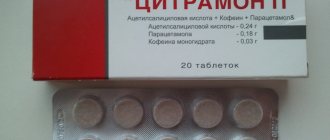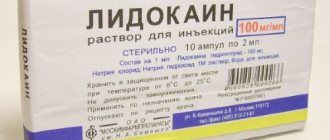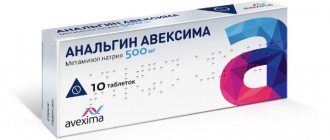How to buy and store medicine?
One of the most popular medications in the home medicine cabinet is paracetamol. Pain relievers help relieve many types of pain. You can buy it at any pharmacy upon request, without presenting the pharmacist with a prescription from a doctor. The drug is affordable. So, 20 tablets of 500 mg cost less than 20 rubles.
The drug “Paracetamol” has been used as a pain reliever for many years. It effectively eliminates pain and lowers body temperature. But it should be remembered that these are only symptoms of the disease, which the drug eliminates. Paracetamol does not cure the disease itself. This means that the symptoms will recur and intensify if you do not seek qualified medical help. This is dangerous to your health.
Paracetamol for fever
Does paracetamol help with fever? Always! It is recommended to reduce the temperature with medicine; if the numbers on the thermometer show above 38, the person feels satisfactory. Paracetamol is an antipyretic drug and should be used to prevent fever and improve well-being. The medicine does not contain additional chemicals, therefore it is relatively safe for adults and children. It is better to use tablets in a single dose of 500 mg, per day - no more than 4 g.
How does the active ingredient work?
Pharmacists in pharmacies often hear the question: “Can I take paracetamol as a pain reliever?” The answer is undoubtedly positive, but a specialist must determine the cause of the pain and only then recommend certain medications.
The substance in question, when entering the human body, works as an analgesic and antipyretic, affecting the production of prostaglandins - suppressing it, and also reduces the excitability of the thermoregulation center of the hypothalamus. Prostaglandins are physiological active substances produced in the human body that sensitize nociceptive receptors to pain mediators - histamine and bradykinin.
Paracetamol suppresses the production of prostaglandins, and therefore reduces the pain threshold. This drug also affects the hypothalamus, one of whose functions is thermoregulation of the body. Paracetamol reduces the activity of the center that performs this important function, as a result of which body temperature decreases.
We suggest you familiarize yourself with How to dilute chlorophyllipt for rinsing gums
The main area of action of paracetamol is the central nervous system, which includes the centers of pain and thermoregulation.
What are the forms of release of the drug?
Paracetamol as an analgesic and antipyretic is used in the treatment of diseases in adults and children. This can be done both by the properties of the medicine itself and its release form: tablets, rectal suppositories, syrup, suspension.
Paracetamol acts as a pain reliever to relieve symptoms of many diseases. Adults in most cases prefer to take pills. This dosage form contains 500 mg of the active ingredient - paracetamol, as well as excipients that play a formative role.
Rectal suppositories are used in pediatrics or in the treatment of patients who are unable to take the drug orally. Suppositories vary in size - 0.08, 0.17 or 0.33 g. They are selected according to the age of the child, as they differ not only in size, but also in the amount of the active component, the content of which can range from 50 to 500 mg in one unit.
For children, pharmaceutical companies produce paracetamol in the form of syrup or suspension. These medicines have not only a liquid texture, but also a pleasant fruity taste and aroma. 5 ml of both syrup and suspension contain 120 mg of active substance.
Interaction of paracetamol with other drugs
Paracetamol is a proven pain reliever, but should not be taken in combination with other painkillers. Some active substances may interact with each other and cause serious liver damage. Such drugs include:
- Carbamazepine,
- Phenobarbital,
- Phenytoin,
- Probenecid,
- Metoclopramide,
- Domperidone,
- Cholestyramine,
- Salicylamide,
- Zidovudine,
- Rifampicin.
Medicines that stimulate certain liver enzymes may increase the unwanted effects of acetaminophen on the liver. These include some sleeping pills, anti-epileptic drugs and the active substance rifampicin.
In addition to paracetamol, it is possible to take a combination drug containing the same active substance. However, the total dose of both drugs should not exceed the maximum daily dose. Adults and adolescents over 12 years of age: single dose - from 500 mg to 1000 mg, maximum daily dose - 4000 mg.
When is the drug used?
Paracetamol as a pain reliever is used in many cases if the pain experienced is mild or moderate in intensity. Most often, as a medicine from a home pharmacy, drugs with this component are taken for toothache, headache, dysmenorrhea, myalgia, neuralgia, back pain, migraine. For colds and fever, these drugs are most in demand.
Paracetamol is also used as an analgesic for joint pain, although its effectiveness in these cases has been little proven. As an anti-inflammatory agent, this drug is used only in complex therapy of the disease, having a minor effect on microorganisms.
The drug is dispensed from the pharmacy chain without a doctor's prescription, but taking it for other purposes, without following the recommendations of the drug manufacturer, is strictly prohibited.
How much does Paracetamol cost in a pharmacy?
Paracetamol is produced by domestic and foreign manufacturers. In the first case, the price of the medicine is significantly lower, but at the same time it is not inferior to foreign analogues in its effectiveness. The drug in dosage for adults can be purchased for approximately 50 rubles, and the children's analogue costs about 90 rubles. For comparison: the cost of medicines from foreign manufacturers is approximately 3 times higher.
Helper medicine
Pain is a sign of certain problems that the body is experiencing. In most cases, people take painkillers to relieve this unpleasant symptom. They believe that the cause of the pain is minor and does not require immediate contact with a specialist.
Paracetamol is a pain reliever used at home, often without prescription. However, this medicine has a fairly long history of use in the treatment of a wide range of diseases or conditions.
We invite you to familiarize yourself with what fillings are used in free dentistry?
Expert opinion about the drug
The drug "Paracetamol" as an analgesic and antipyretic agent has been used in medical practice for several decades. And this speaks for itself - experts consider it effective in solving the problem of pain of mild and moderate intensity, as well as lowering body temperature in certain diseases.
Doctors recommend taking the drug only in the indicated dosage, without violating the duration of use and taking into account the existing contraindications for each patient. The hepatotoxic effect of paracetamol forces one to take into account the patient’s medical history, the presence of liver and kidney diseases, and also forces one to stop drinking alcohol when taking paracetamol.
Experts prescribe this drug in a specific dosage form for each age group, because the pharmaceutical industry produces several medicinal types that take into account the characteristics of the body or the health status of many patients.
Side effects
Taking non-narcotic painkillers (aspirin, ibuprofen and paracetamol) during pregnancy increases the risk of developmental disorders of the genital organs in newborn boys in the form of cryptorchidism. The results of the study showed that the simultaneous use of two of the three listed drugs during pregnancy increases the risk of having a child with cryptorchidism up to sixteen times compared with women who did not take these drugs [26].
However, England's Medicines and Healthcare Products Regulatory Agency has raised concerns about the interpretation of data from studies looking at the effects of paracetamol on asthma and eczema and offers the following advice for healthcare professionals, parents and carers: " The results of this new study do not imply any changes to the current guidelines for use in children. The evidence from this study is insufficient to change the guidelines regarding the use of antipyretics in children."[6]
Scientists from Ohio University found that taking paracetamol weakens the emotional response experienced by a person. Of 82 people who looked at a set of photographs an hour after taking the pill, the level of emotionality of the photographs on a 10-point scale rated by subjects who took paracetamol averaged 5.85, while the same value in the control group who took placebo was 6.76 [27 ][28][29][30]. Earlier studies by Canadian scientists showed a similar result.[31]
Paracetamol toxicity
In recent years, data have emerged on the hepatotoxic effect of paracetamol in moderate overdose, when paracetamol is prescribed in high therapeutic doses and while taking alcohol or inducers of the microsomal liver enzyme system P-450 (antihistamines, glucocorticoids, phenobarbital, ethacrynic acid).
A single dose of paracetamol in a dose of more than 10 g in adults or more than 140 mg/kg in children leads to poisoning, accompanied by severe liver damage. The reason is the depletion of glutathione reserves and the accumulation of intermediate products of paracetamol metabolism, which have a hepatotoxic effect. A similar picture can be observed when taking regular doses of the drug in the case of concomitant use of inducers of cytochrome P-450 enzymes and in alcoholics, as well as in people who regularly drink alcohol (for men - daily intake of more than 700 ml of beer or 200 ml of wine, for women - the dose is 2 times less), especially if paracetamol was taken a short period of time after drinking alcohol [32].
There is evidence that severe hepatotoxicity in adults can develop even with a single dose of 7.5 g of paracetamol [33].
Uncontrolled use of paracetamol often causes gastrointestinal bleeding, the treatment of which requires hospitalization. In some cases, death occurs[22].
When intoxicated with paracetamol, it must be borne in mind that forced diuresis is ineffective and even dangerous; peritoneal dialysis and hemodialysis are ineffective. In no case should you use antihistamines, glucocorticoids, phenobarbital and ethacrynic acid, which can have an inducing effect on cytochrome P-450 enzyme systems and increase the formation of hepatotoxic metabolites.
The path of medicine in the human body
How to take paracetamol as an analgesic or antipyretic is described in the instructions for use included in the manufacturer's packaging. But the pharmacokinetics will be the same in any case. Once in the gastrointestinal tract, paracetamol is actively absorbed into the systemic circulation, reaching its maximum concentration after 0.5-2 hours.
It binds to blood plasma proteins by 15%. The plasma half-life is approximately 2-4 hours. The metabolic processes of paracetamol take place mainly in the liver, where almost 80% of the active substance reacts with glucuronic acid and sulfates, forming inactive metabolites - paracetamol glucuronide and sulfate.
17% of paracetamol undergoes hydroxylation, resulting in the formation of 8 active metabolites, which in turn conjugate with glutathione and form inactive metabolites. If there is not enough glutathione for metabolic processes, then these metabolites can block the enzyme systems of hepatocytes, which will cause their necrosis.
We suggest you familiarize yourself with Blue spot on the tongue - ProfiMed
The CYP2E1 isoenzyme is also involved in the metabolism of the active substance. paracetamol metabolites are excreted mainly by the kidneys.
Indications
Paracetamol is a common non-narcotic analgesic. It is on the World Health Organization's list of essential drugs.
It has been established that paracetamol is a weak inhibitor of prostaglandin biosynthesis, and its blocking effect on the synthesis of prostaglandins, mediators of pain and temperature response, occurs to a greater extent in the central nervous system than in the periphery. This explains the presence of a pronounced analgesic and very weak anti-inflammatory effect.
Paracetamol practically does not bind to plasma proteins, easily penetrates the blood-brain barrier, and is almost evenly distributed in the brain. The drug begins to have a rapid antipyretic and analgesic effect within 20-30 minutes and continues to act for about 4 hours. The period of complete elimination of the drug is on average 4.5 hours. The drug is predominantly excreted by the kidneys (98%), the main part of the administered dose is biotransformed in the liver.
Paracetamol has virtually no effect on the gastric mucosa and does not cause an ulcerogenic effect. This also explains the absence of bronchospasm, which allows the use of paracetamol in the treatment of patients suffering from bronchial asthma.
Unlike aspirin, the drug does not affect the hematopoietic system and blood clotting. These advantages and the wide range of therapeutic effects of paracetamol have now allowed it to take its rightful place among other non-narcotic analgesics.
Paracetamol is used for:
- elevated temperature;
- colds;
- infectious and inflammatory diseases;
- headache;
- toothache;
- migraine;
- myalgia;
- neuralgia;
- algodismenorrhea;
- pain associated with injuries;
- burns;
- osteoarthritis;
- febrile syndrome;
- during menstruation;
- with a hangover, it significantly improves the general condition of the body.
Reviews about taking paracetamol for menstrual pain
Maria, 25 years old, Kirov
I have had periods since I was 14 years old, and each time they were accompanied by terrible pain. Doctors said that this happens and will go away with age. Paracetamol was recommended as a drug for pain relief. It has been helping me for many years because with age, unfortunately, the unpleasant sensations have not gone away.
Alexandra, 32 years old, Petrozavodsk
I started having periods at the age of 13, but from the age of 15 they began to be accompanied by severe pain and profuseness on the first day. A friend advised me to take paracetamol. After some time, I began to notice that after taking the pill, the discharge became less abundant. Now there are no such strong pain sensations, but the profusion remains, so sometimes I take the drug in order to reduce the volume of discharge, especially if I need to go somewhere on the days of my period.
Paracetamol is an effective remedy for menstrual cramps and, according to doctors, the safest of all possible options. Before using it, you should read the instructions for use and, if in doubt, consult a doctor. There are a large number of tablets for pain during menstruation, and every woman will be able to choose a more suitable remedy for herself.
Use for the stomach
The drug can be taken if severe pain is felt in the digestive organ.
Paracetamol has also found its use for gastritis. This disease is characterized by inflammation of the gastric mucosa, which is accompanied by painful sensations in the epigastrium and increased body temperature. Paracetamol is often used for the hyperacid form of gastritis, when patients notice severe pain in the stomach. The pharmaceutical drug will help minimize pain and normalize body temperature.
However, Paracetamol should be used for stomach problems only after consulting a doctor. Uncontrolled use of medication can negatively affect your health.
The dosage and duration of taking the medication is determined by a specialized physician individually for each patient. According to the instructions, to relieve pain, Paracetamol is used for up to 10 days, 1-2 tablets per day. The dragees are swallowed whole and washed down with plenty of water. It can be used as an antipyretic for no longer than 3 days in a row.
Patient reviews
Many customers in pharmacies ask whether Paracetamol can be taken as a pain reliever in certain situations, and reviews from ordinary people say that this drug is quite effective in relieving toothache, muscle pain, headache or menstrual malaise.
According to many patients, paracetamol is a good remedy for eliminating colds in children and adults. Many note a wide selection of dosage forms of drugs under the name being studied to take into account the age characteristics of the patient. In addition, the drug is sold in pharmacies without a prescription from a doctor, and its price makes the medicine accessible to all segments of the population.
Dosage
The tablets are produced in various dosages, which makes them much easier to take.
Paracetamol 200 mg
The product is convenient to use for treating children aged 3 to 12 years. Of course, the dosage, as mentioned earlier, is calculated individually depending on the baby’s weight. But in most cases, children under 6 years of age take 1 tablet, and older children, in agreement with the doctor, are allowed to take two tablets.
Paracetamol 325 mg
Dosage 325 is prescribed to relieve pain and lower fever for children over 12 years of age and adults. It is allowed to take two tablets at a time in consultation with the doctor.
Paracetamol 500 mg
500 tablets are mainly suitable for treating adults. The optimal dose is 1 tablet at a time. In severe cases with severe pain, the doctor may double the single dose.










